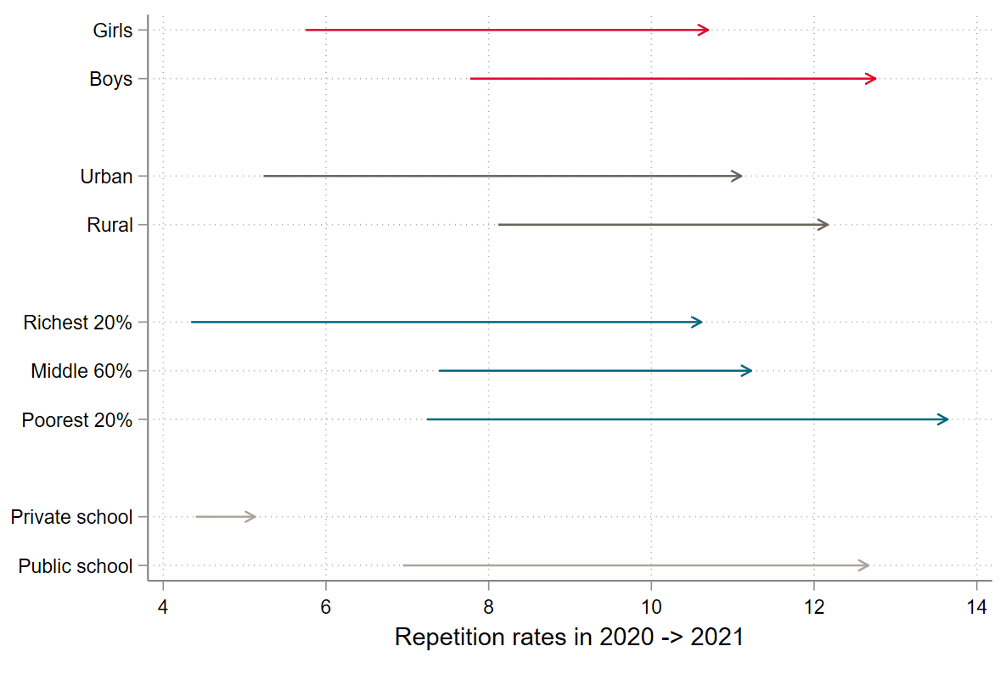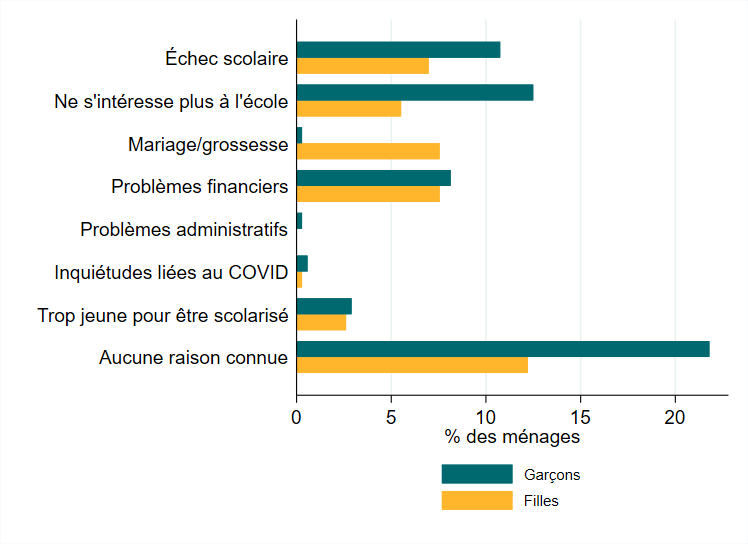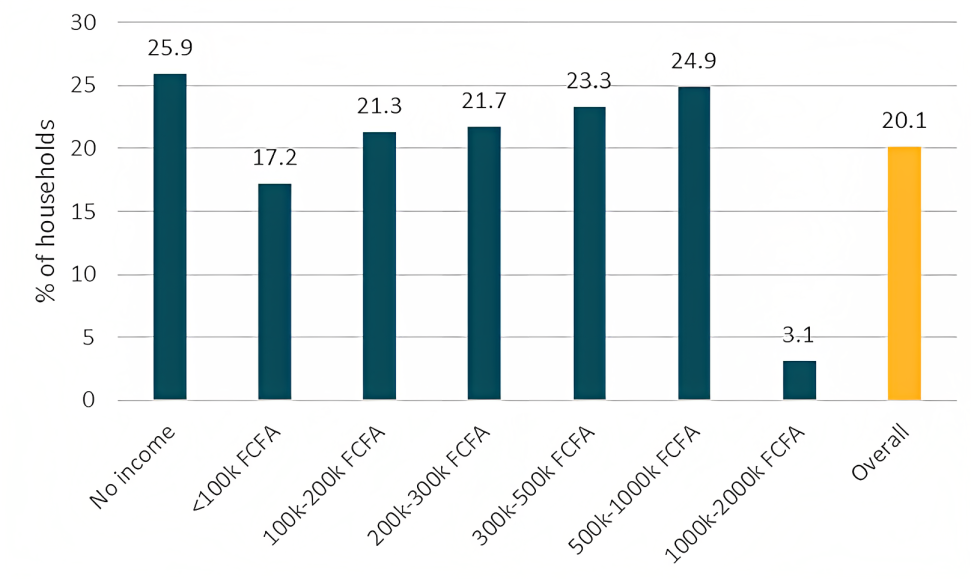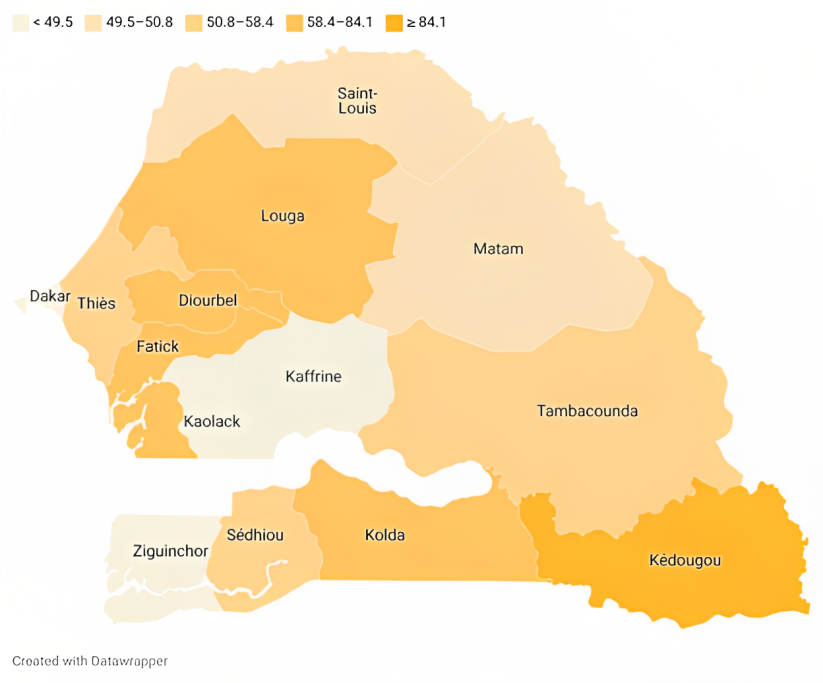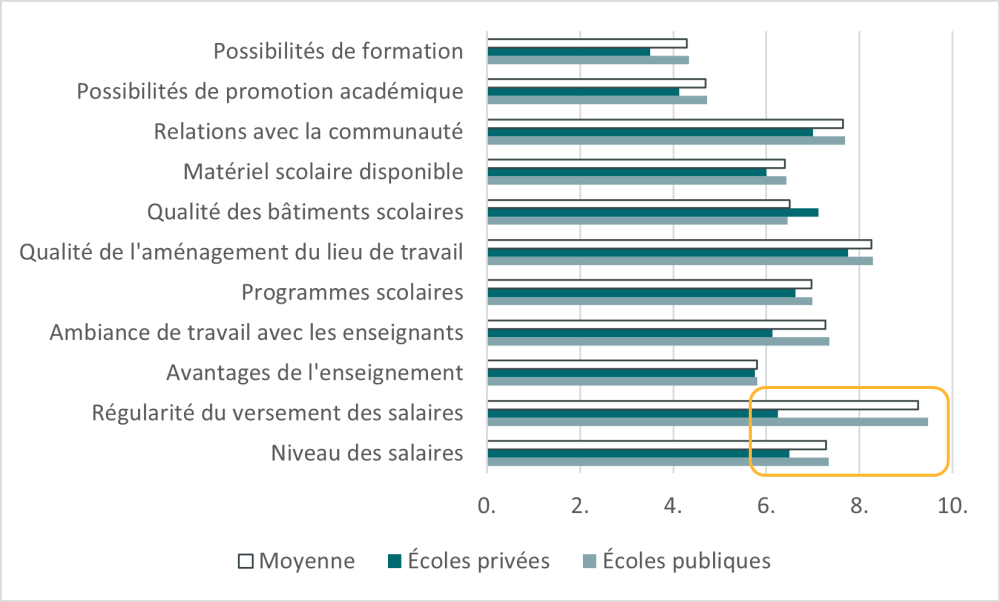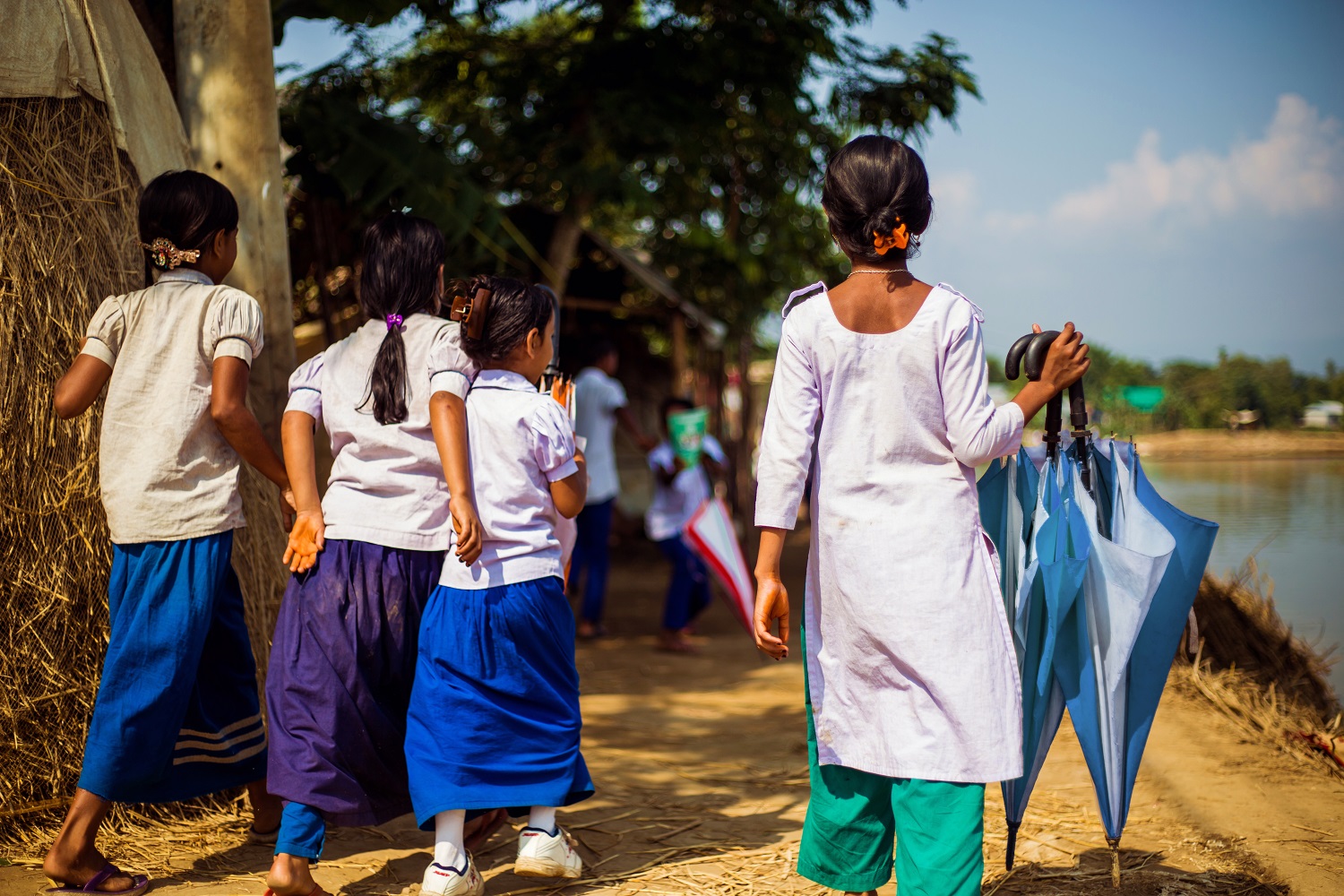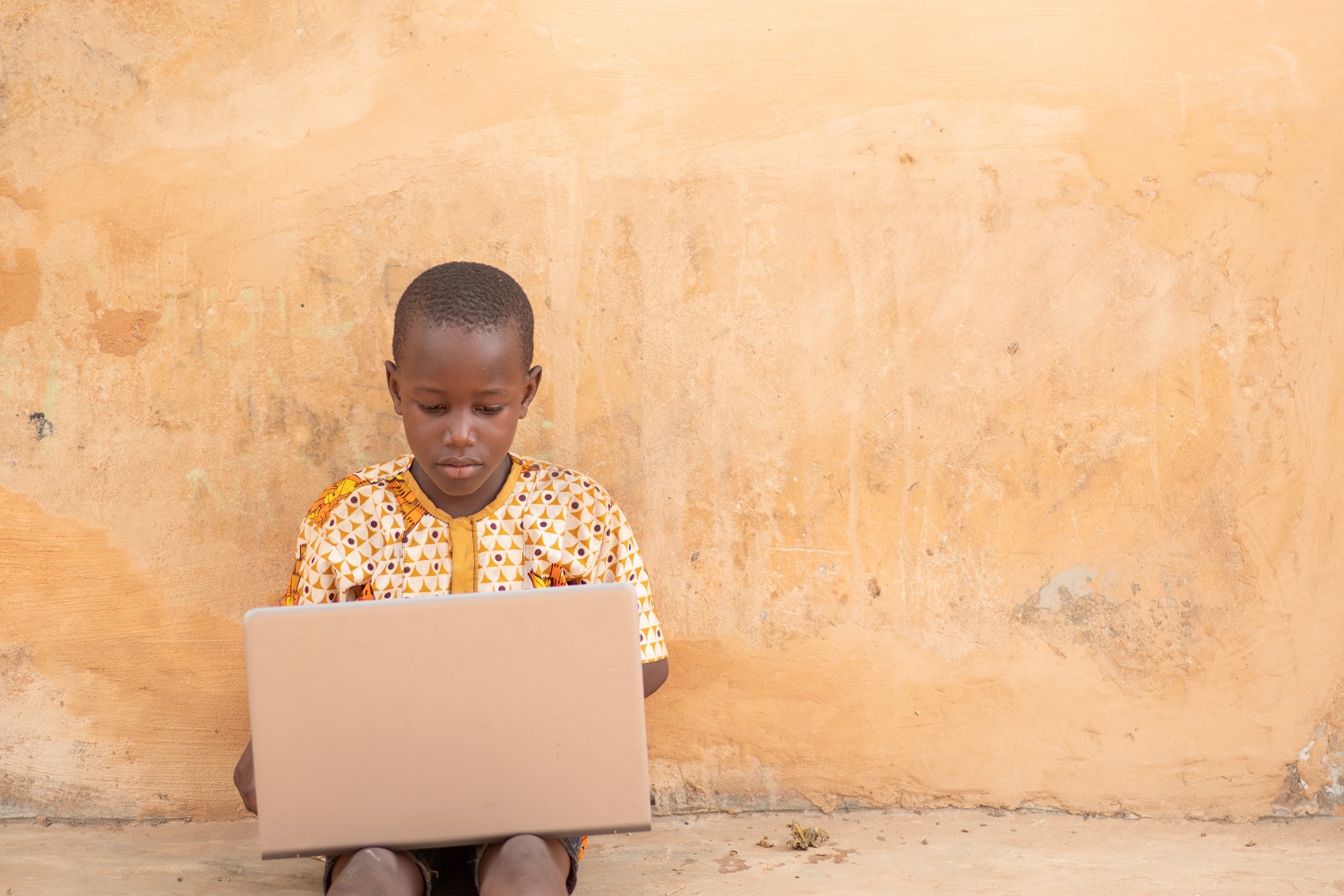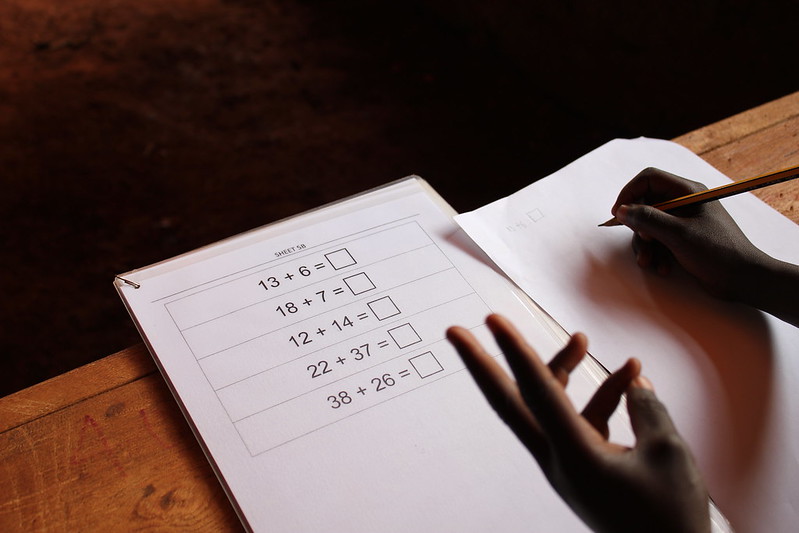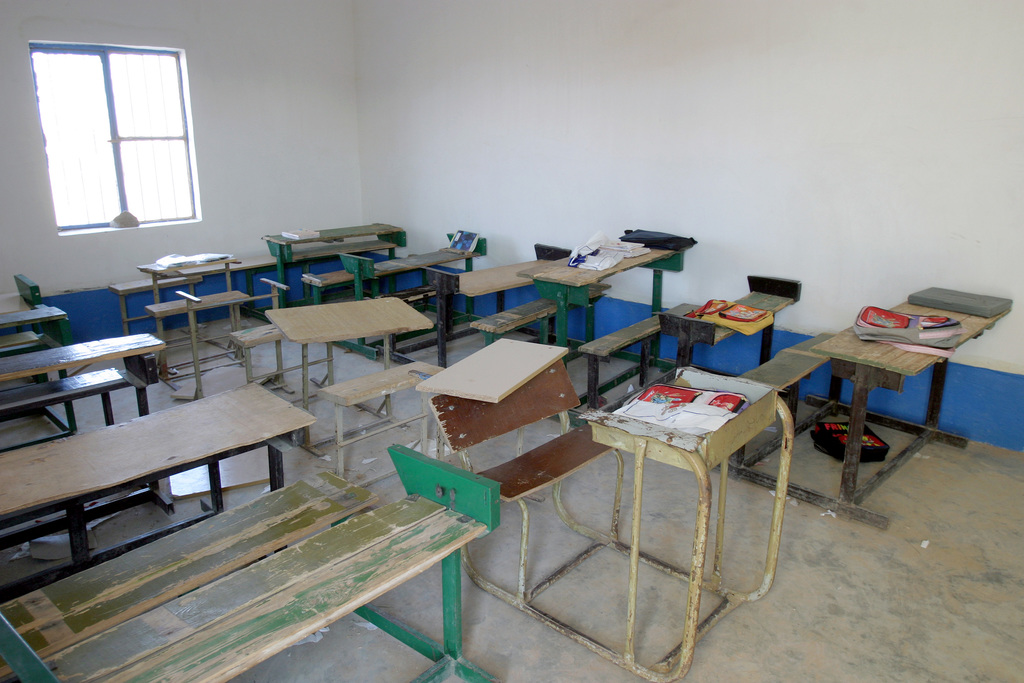Recommended
When Senegal closed schools for nearly seven months because of COVID, it disrupted education for over 3.5 million learners. In our multi-phase study, we fill the gaps in understanding the impacts of these closures on students and the education sector broadly. In the first part of the study, we described the immediate impacts of school closures on children’s access to education in Senegal using data from our first round of surveys of 1,000 households in 2021. Nearly two years on, through a follow-up survey of 982 households and 119 schools, we investigate the longer-term consequences of the pandemic on Senegal’s education system.
Dropout rates doubled for boys and tripled for girls in rural areas between 2021 and 2022
In 2021, we found that enrollment had recovered and dropout rates had not changed, but repetition rates had gone from 6.6 percent in 2019-2020 to 12.1 percent in 2020-2021. Grade repetition not only directly impacts learning for future cohorts, it also reduces the efficiency of government expenditure on educationand greatly increases the probability that a child will drop out of school, prompting concern about the long-run effects of school closures on education.
These fears are confirmed by our findings from the second wave of surveys; enrollment has fallen from 92.5 percent in 2021 to 85 percent in 2022. Two-thirds of students who repeated a year in 2020-2021 dropped out of school in the next academic year. Contrary to expectations, we do not find any significant differences in enrollment by wealth status of households, but the urban-rural divide is widening. In rural areas, the drop-out rate among school-age boys doubled between 2021 and 2022 (from 11.3 percent to 20.6 percent) and that almost tripled among girls (from 5.6 percent to 15.5 percent), unlike in urban areas, where drop-out rates for both sexes have remained at similar levels.
Although we find that the dropout rate is higher among boys (18 percent) than girls (13 percent), recent studies find that cultural norms and financial barriers especially limit girls’ access to schools in Senegal. Our data suggests that dropouts are driven by academic failure (18 percent), financial constraints (16 percent), and lack of interest (16.5 percent). School failure (18 percent) and disengagement (21 percent) are much more prevalent among boys than among girls. Marriage/pregnancy and financial constraints were both cited by 17 percent of the girls who did not return to school in our sample (see Figure 1).
In Senegal nearly a third of women are married before the age of 18 (compared to 1 percent boys), and more than two-thirds of school dropouts due to pregnancy for girls occur in middle school. In our survey we found that child marriage increased slightly from 16 percent to 19 percent between 2021 and 2022, but continues to disproportionately affect girls (29 percent) compared to boys (5 percent). Although early marriage rates in Senegal have reduced steadily over time, differences in prevalence based on region and wealth status are vast, driving some of these figures.
Figure 1: Reasons for dropping out of school for boys and girls
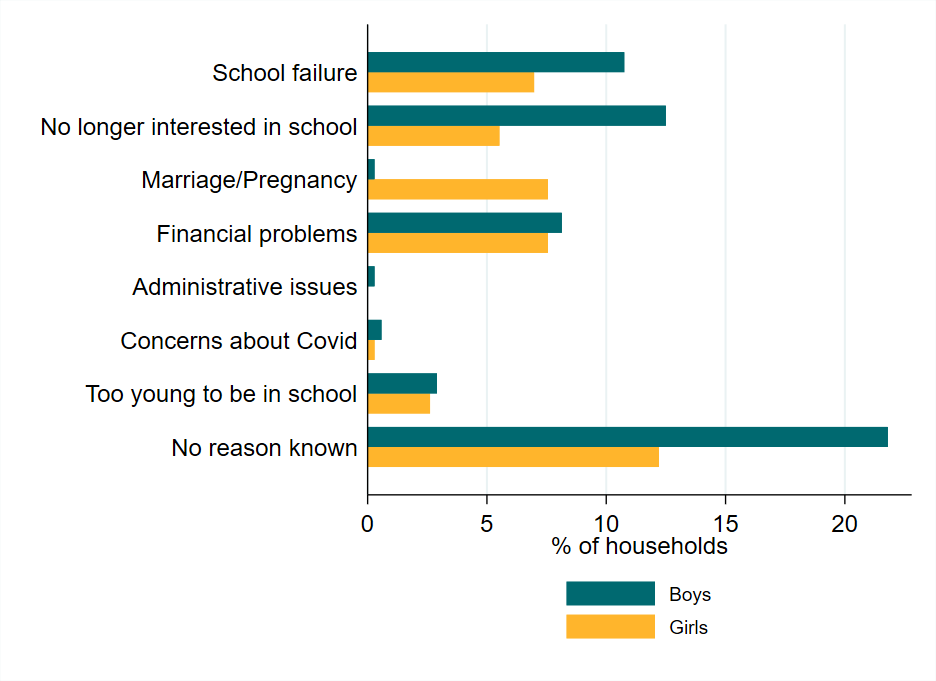
Household expenditure on schooling is rising, and parents are more involved in their children’s education than before the pandemic
Another result highlighted in our first round was the increased use of private education and after-school care among the most affluent families. In our second round of surveys we find that this phenomenon is now more widespread: private tutoring rates have increased significantly, from 8 percent in 2021 to just over 30 percent in 2022, across income groups (See Figure 2). Families are making efforts to support students with schooling, even if they can’t afford to pay for private tutoring. In our survey, we find that in these cases, family members help the students (siblings, cousins, etc).
Figure 2: Increase in rates of private tutoring by income group, between phase 1 (2021) and phase 2 (2022) surveys
Urban parents are choosing private schools, but public school teachers were more motivated during the pandemic according to our “teacher motivation index”
The "migration" of students between public and private schools is a recurring phenomenon in Senegal. Given the economic crisis resulting from the pandemic, we expected to see a large proportion of students moving from costlier private education to universal free public education. Overall, we find that the majority (91 percent) of students have not changed school type between 2020-21 and 2021-22, but curiously a higher proportion of students (4.8 percent) left public school for private school compared to those (3.5 percent of students) moving the other way. Households in the middle of the income distribution were more likely than others to move their kids from public to private schools. In urban areas, a similar share of students migrated between school types (around 8 percent), whereas in rural areas only 1 percent of students moved from private to public schools.
Perceptions of higher teaching quality at private schools might lead to this preference for private schools in the post-pandemic era; over 70 percent of parents in our study expressed concerns about learning loss among children as a result of pandemic-related school closures. Our data additionally suggest that parents preferred private schools due to their discomfort with government handling of the pandemic and restrictions enforced in public schools. This is reinforced by our findings that private schools continued to maintain higher restrictions for pupils and especially teachers than public schools in 2022, despite a general relaxing of restrictions in the country. Private schools in Senegal were extremely popular before the pandemic and continue to be reliable alternatives to public schooling. However, the pandemic severely constrained school finances, particularly for more newly established and small private schools. Private schools may feel the need to demonstrate that they are a safe place for students in order for parents to enroll their children and guarantee continued business for private operators.
We also gathered data to construct a “teacher motivation index,” asking teachers to grade on a scale of 1 to 10 how well their school handled the pandemic, as well as teacher salary and benefits (like training opportunities, promotions, etc). Teachers are important actors in the success of educational projects and programmes, and crucial drivers of school quality. Their compliance and motivation, especially during a crisis, guarantees effective implementation of policies for student safety as well as learning loss mitigation and recovery.
Regional differences prevail (see Figure 3), as has been the case in Senegal historically. Teachers from Kédougou region were the most motivated, rating their schools with an average score of 84.1 (out of 100), while Ziguinchor (44.5) and Dakar (42.7) have the lowest average values, where teachers were most dissatisfied with their working conditions during the pandemic.
Figure 3: Primary teacher motivation index (mean score out of 100) across regions in Senegal

Pre-primary teachers reported higher motivation than those teaching primary levels. We also observe that public school teachers were more motivated than private school teachers, a finding that persisted between both waves of our survey. Teachers’ rankings of individual components of our teacher motivation index reveal that the only component in which private school teachers are more satisfied is related to the quality of school buildings. On average, a difference of about 12 points (out of 100) is noted between teachers in public (52.2 mean score) and private schools (40.1 mean score).
Figure 4: Private and public school teachers’ levels of satisfaction during the pandemic, across components of our teacher motivation index
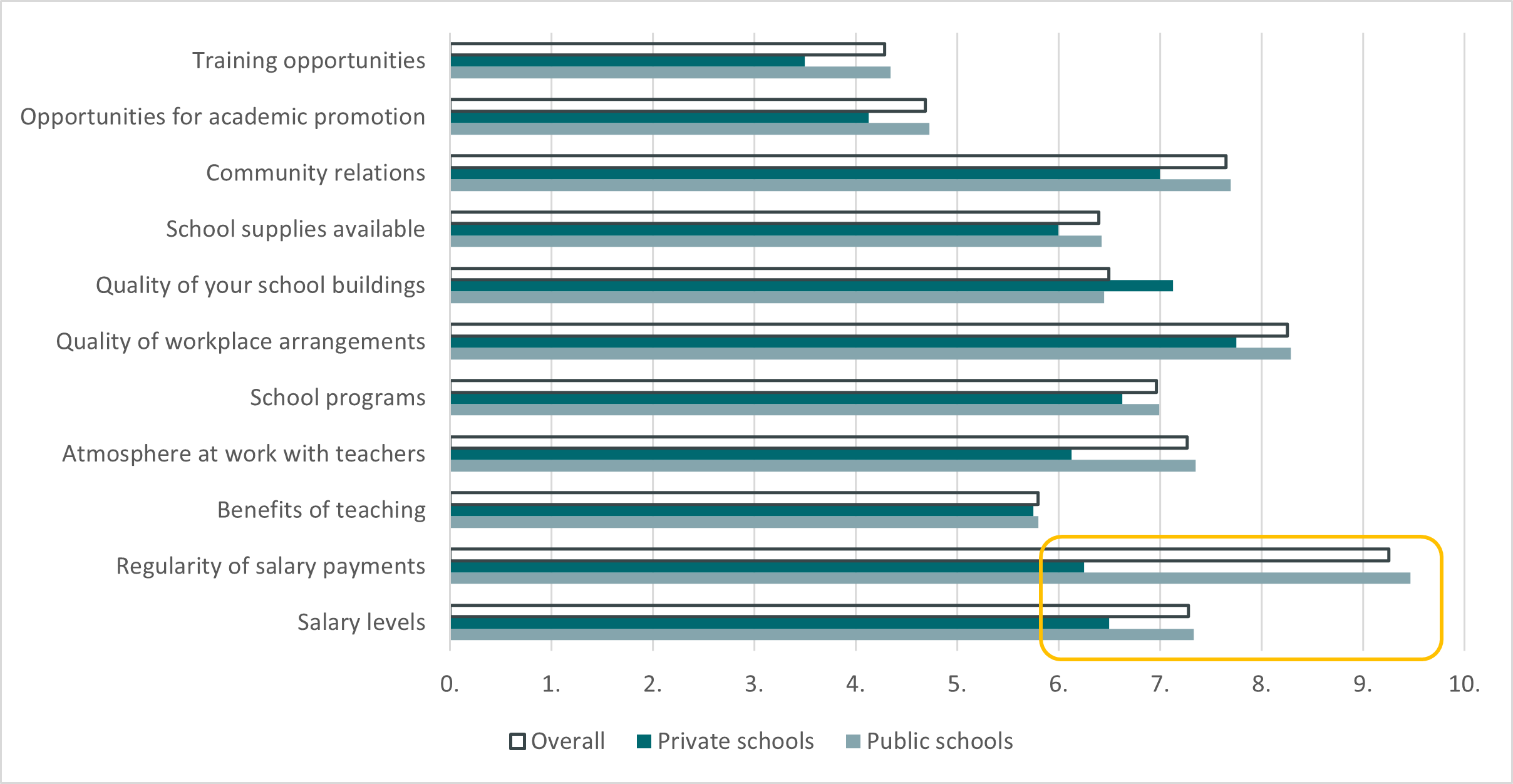
Government support to teachers, especially those in private schools, has increased markedly in the aftermath of the pandemic, and was observed between the two rounds of survey. In particular, there has been a pay rise for civil service workers engaged in primary and secondary education. By contrast, the decree for private sector wage increases was only announced recently and will not take effect until next year.
Discontent among private school teachers with salaries and payments is reflected clearly in our survey data (see Figure 4). Teachers in public schools report having received better salaries, more regularly than private school counterparts. Private schools also provided poorer working conditions, and lower quality arrangements during the pandemic.
To enable equal access to education in future crises, rural students and girls will need support
We are also able to provide a glimpse of the dynamic nature of reactions from parents, teachers, and the education system over the course of an emergency. Parents continue to recognise the impact of the pandemic on their children’s learning levels and are attempting to support them through private tuition. Continued restrictions at schools were more attractive to parents seeking to enroll their children in a safe environment. Teachers were highly motivated in the early stages of the pandemic, but lack of adequate support through salaries and incentives reduced their satisfaction, and could directly impact school quality. Targeted regional interventions could be an efficient way to improve overall education delivery in the country.
With thanks to Maimouna Konate for research assistance
Lorsque le Sénégal a fermé ses écoles pendant près de sept mois en raison de la pandémie de COVID, l’éducation de plus de 3,5 millions d’élèves a été bouleversée. Dans une étude en plusieurs étapes, nous nous efforçons de mieux comprendre l’impact de ces fermetures sur les élèves et le secteur de l’éducation en général. La première partie de l’étude décrivait les conséquences immédiates des fermetures d’écoles sur l’accès des enfants à l’éducation au Sénégal, à l’aide de données issues de notre première série d’enquêtes auprès de 1000 ménages en 2021. Près de deux ans plus tard, une enquête de suivi portant sur 982 ménages et 119 écoles étudie les conséquences à long terme de la pandémie sur le système éducatif sénégalais.
Dans les zones rurales, entre 2021 et 2022, les taux d’abandon scolaire des garçons ont doublé et ceux des filles ont triplé
En 2021, nous avions constaté que les inscriptions avaient repris et que les taux d’abandon étaient stables, mais que les taux de redoublement étaient passés de 6,6 % en 2019-2020 à 12,1 % en 2020-2021. Non seulement le redoublement a un impact direct sur la durabilité de l’apprentissage pour les groupes d'élèves, mais il réduit en outre l'efficacité des dépenses publiques en matière d’éducation et augmente considérablement les risques d’abandon scolaire, ce qui suscite des préoccupations sur les effets à long terme des fermetures d’écoles.
Ces craintes sont de fait confirmées par les résultats de notre seconde série d’enquêtes : le taux de scolarisation est passé de 92,5 % en 2021 à 85 % en 2022. Les deux tiers des élèves ayant redoublé en 2020-2021 ont abandonné l’école lors de l’année scolaire qui a suivi. Contrairement aux attentes, nous ne constatons pas d’écarts significatifs de scolarisation en fonction du niveau de richesse des ménages. Cependant, le fossé entre les zones urbaines et rurales se creuse. Dans les zones rurales, le taux d’abandon des garçons en âge d’être scolarisés a doublé entre 2021 et 2022 (de 11,3 % à 20,6 %) et celui des filles a presque triplé (de 5,6 % à 15,5 %), tandis que dans les zones urbaines, les taux d’abandon pour les deux sexes sont restés quasiment inchangés.
Bien que le taux d’abandon soit plus élevé chez les garçons (18 %) que chez les filles (13 %), des études récentes montrent qu’au Sénégal, les normes culturelles et les obstacles financiers limitent plus particulièrement l’accès des filles à l’école. Nos données suggèrent que les abandons sont dus à l’échec scolaire (18 %), aux contraintes financières (16 %) ou à un manque d’intérêt (16,5 %). L’échec scolaire (18 %) et le désengagement (21 %) sont beaucoup plus fréquents chez les garçons que chez les filles. Le mariage/la grossesse et les contraintes financières sont deux raisons invoquées par 17 % des filles de notre échantillon qui ne sont pas retournées sur les bancs de l’école (voir figure 1).
Au Sénégal, près d’un tiers des jeunes filles se marient avant l’âge de 18 ans (contre 1 % des garçons). Plus des deux tiers des abandons scolaires pour cause de grossesse surviennent au collège. Notre enquête a révélé que les mariages d’enfants avaient légèrement augmenté, passant de 16 % à 19 % entre 2021 et 2022, mais qu’ils continuent d’affecter de manière disproportionnée les filles (29 %) par rapport aux garçons (5 %). Bien que les taux de mariage précoce au Sénégal aient régulièrement baissé au fil du temps, les écarts de prévalence en fonction de la région et du niveau de richesse sont considérables, ce qui explique certains de ces chiffres.
Figure 1 : Motifs d’abandon scolaire chez les garçons et les filles
Les dépenses des ménages pour la scolarisation augmentent et les parents sont plus impliqués dans l’éducation de leurs enfants qu’avant la pandémie
Un autre résultat notable de notre première série d’enquêtes était le recours accru à l’enseignement privé et à la garde périscolaire dans les familles les plus aisées. Dans notre deuxième série d’enquêtes, nous constatons que ce phénomène est désormais plus répandu : les cours particuliers ont augmenté de manière significative, passant de 8 % en 2021 à un peu plus de 30 % en 2022, toutes catégories de revenus confondues (voir figure 2). Les familles s’efforcent de soutenir les élèves dans leur scolarité, même si elles n’ont pas les moyens de financer des cours particuliers. Dans ce cas, nos enquêtes révèlent que ce sont les membres de la famille qui assument ce rôle (frères et sœurs, cousins, etc.).
Figure 2 : Augmentation des taux de cours particuliers par groupe de revenu, entre les enquêtes de la phase 1 (2021) et de la phase 2 (2022)
Les parents des zones urbaines se tournent vers les écoles privées. Or, selon notre « indice de motivation des enseignants », le corps enseignant des écoles publiques était davantage motivé durant la pandémie
La « migration » des élèves du public vers le privé est un phénomène récurrent au Sénégal. Compte tenu de la crise économique résultant de la pandémie, nous nous attendions à ce qu’une grande partie des élèves passent de l’enseignement privé, plus coûteux, à l’enseignement public, qui est universel et gratuit. Dans l’ensemble, nous constatons que la majorité d’entre eux (91 %) n’a pas changé de type d’établissement entre 2020-21 et 2021-22. Mais curieusement, la proportion d’élèves ayant quitté l’école publique pour l’école privée (4,8 %) est plus importante que celle des élèves ayant fait le chemin inverse (3,5 %). Les ménages disposant de revenus moyens étaient plus susceptibles de faire passer leurs enfants du public au privé. Dans les zones urbaines, la part des élèves ayant changé de type d’établissement (environ 8 %) est restée équivalente, tandis que dans les zones rurales, seul 1 % des élèves ont migré du public vers le privé.
La perception d’une meilleure qualité de l’enseignement dans les écoles privées peut expliquer cette préférence à l’ère post-COVID : plus de 70 % des parents interrogés dans le cadre de notre étude ont exprimé leur inquiétude concernant le déficit d’apprentissage lié aux fermetures d’écoles durant la pandémie. Nos données suggèrent en outre que les parents ont préféré les écoles privées en raison de leur malaise face à la gestion de la pandémie par le gouvernement et aux mesures de restriction appliquées dans les écoles publiques. Ce constat est renforcé par les informations selon lesquelles les écoles privées ont continué à appliquer en 2022 des restrictions pour les élèves, mais surtout pour les enseignants, qui étaient plus strictes que celles des écoles publiques, malgré un assouplissement général dans le pays. Au Sénégal, les écoles privées étaient extrêmement populaires avant la pandémie et continuent d’être une alternative fiable à l’enseignement public. Néanmoins, la pandémie a fortement affaibli les finances des écoles, en particulier celles des établissements privés récemment ouverts et de petite taille. Les écoles privées ont probablement besoin de démontrer qu’elles sont des lieux sûrs pour les élèves afin d’inciter les parents à y inscrire leurs enfants et de garantir la poursuite de leur activité.
Nous avons également recueilli des données pour élaborer un « indice de motivation des enseignants », en demandant aux enseignants d’évaluer sur une échelle de 1 à 10 la manière dont leur école a géré la pandémie, ainsi que leurs salaires et avantages (comme les possibilités de formation, de promotion, etc.). Les enseignants sont des acteurs importants de la réussite des projets et des programmes éducatifs, et des contributeurs essentiels à la qualité de l’éducation scolaire. Leur respect des règles et leur motivation, en particulier en période de crise, garantissent une mise en œuvre efficace des politiques relatives à la sécurité des élèves, afin de limiter les déficits d’apprentissage et de récupérer les acquis.
Les écarts régionaux prévalent (voir figure 3), comme cela a toujours été le cas au Sénégal. Les enseignants de la région de Kédougou ont été les plus motivés, avec un score moyen de 84,1 (sur 100), tandis que Ziguinchor (44,5) et Dakar (42,7) ont enregistré les valeurs moyennes les plus basses, leurs enseignants étant les plus mécontents de leurs conditions de travail pendant la pandémie.
Figure 3 : Indice de motivation des enseignants du primaire (score moyen sur 100) dans les différentes régions du Sénégal
Les enseignants en maternelle ont manifesté une motivation plus grande que ceux du primaire. Nous avons aussi observé que les enseignants des écoles publiques étaient plus motivés que ceux des écoles privées, un phénomène qui persiste d'une série d’enquêtes à l’autre. La notation par les intéressés des différents critères de notre indice de motivation des enseignants révèle que le seul critère sur lequel les enseignants du privé sont plus satisfaits est celui lié à la qualité des bâtiments scolaires. Globalement, une différence d’environ 12 points (sur 100) sépare les enseignants des écoles publiques (moyenne de 52,2) de ceux des écoles privées (moyenne de 40,1).
Figure 4 : Niveaux de satisfaction des enseignants des écoles privées et publiques durant la pandémie, en fonction des critères de notre indice de motivation des enseignants
Le soutien du gouvernement aux enseignants, en particulier ceux des écoles publiques, s’est considérablement accru à la suite de la pandémie, une progression ayant été observée entre les deux séries d’enquêtes. Les travailleurs de la fonction publique embauchés dans l’enseignement primaire et secondaire ont notamment bénéficié de hausses des salaires. En revanche, le décret sur les augmentations salariales dans le secteur privé n’a été annoncé que récemment et n’entrera pas en vigueur avant l’an prochain.
Le mécontentement des enseignants du privé concernant les traitements et salaires apparaît clairement dans les données de notre enquête (voir figure 4). Les enseignants des écoles publiques déclarent avoir perçu de meilleurs salaires, avec plus de régularité, que leurs confrères des écoles privées. Les conditions de travail et les dispositions prises durant la pandémie dans les écoles privées étaient également moins bonnes.
Pour que l’accès à l’éducation soit équitable lors des prochaines crises, les élèves des zones rurales et les filles auront besoin de soutien
Nous sommes également en mesure de témoigner de la réactivité dont les parents, les enseignants et le système éducatif ont fait preuve en situation d’urgence. Les parents continuent de mesurer l’impact de la pandémie sur le niveau d’apprentissage de leurs enfants et tentent de les soutenir en les orientant vers des cours privés. Le maintien des restrictions dans les écoles était plus rassurant pour les parents soucieux de placer leurs enfants dans un environnement sûr. Les enseignants étaient très motivés au début de la pandémie, mais l’absence de soutien adapté, à travers les salaires ou d’autres incitations, a érodé leur satisfaction, ce qui pourrait avoir un impact direct sur la qualité de l’enseignement. Des interventions régionales ciblées pourraient être un moyen efficace d’améliorer l'offre éducative dans son ensemble au sein du pays.
Nous remercions Maimouna Konate pour son aide à la recherche
Disclaimer
CGD blog posts reflect the views of the authors, drawing on prior research and experience in their areas of expertise. CGD is a nonpartisan, independent organization and does not take institutional positions.


